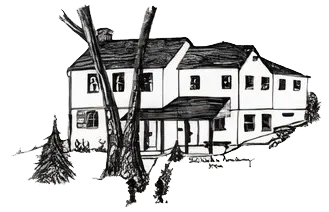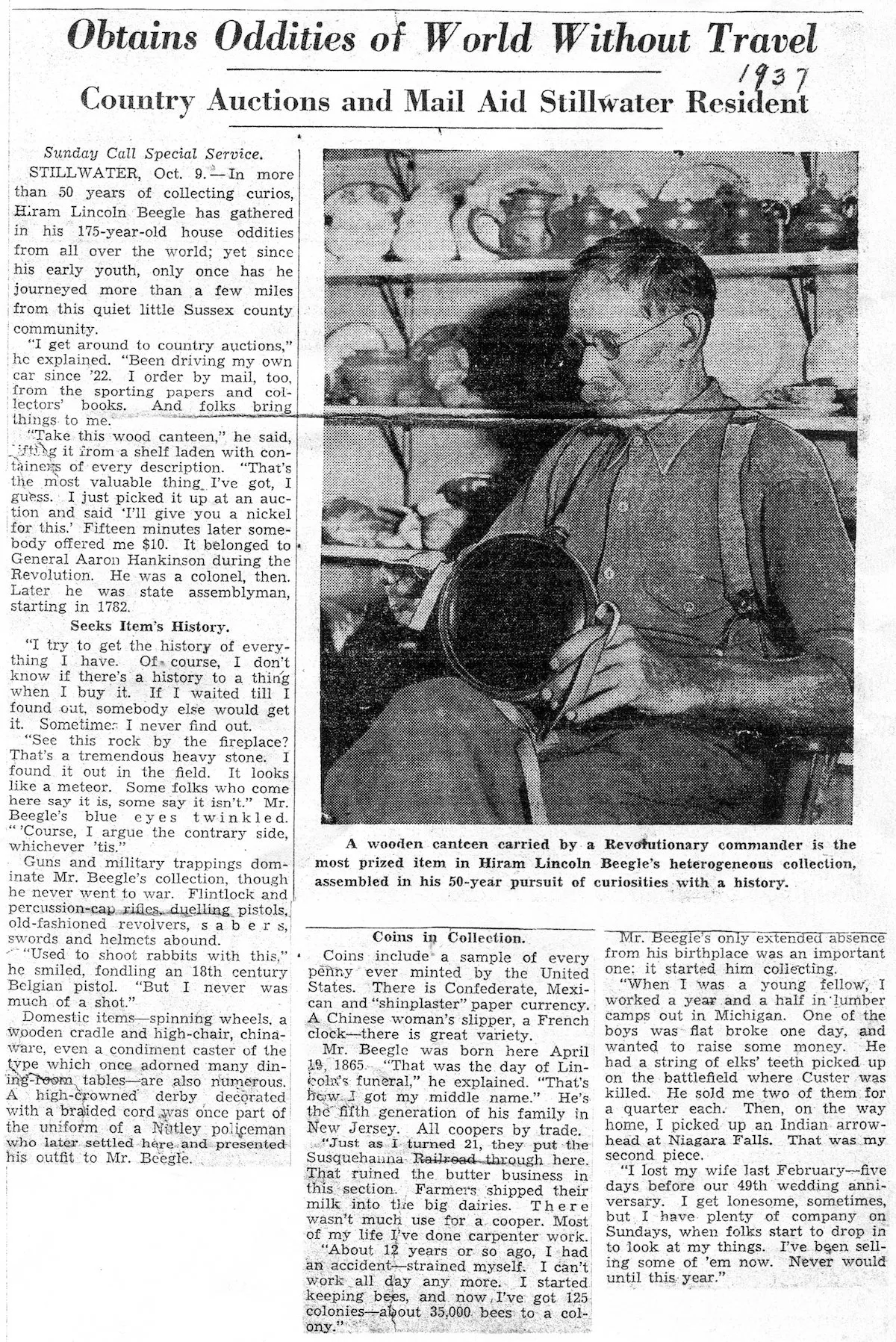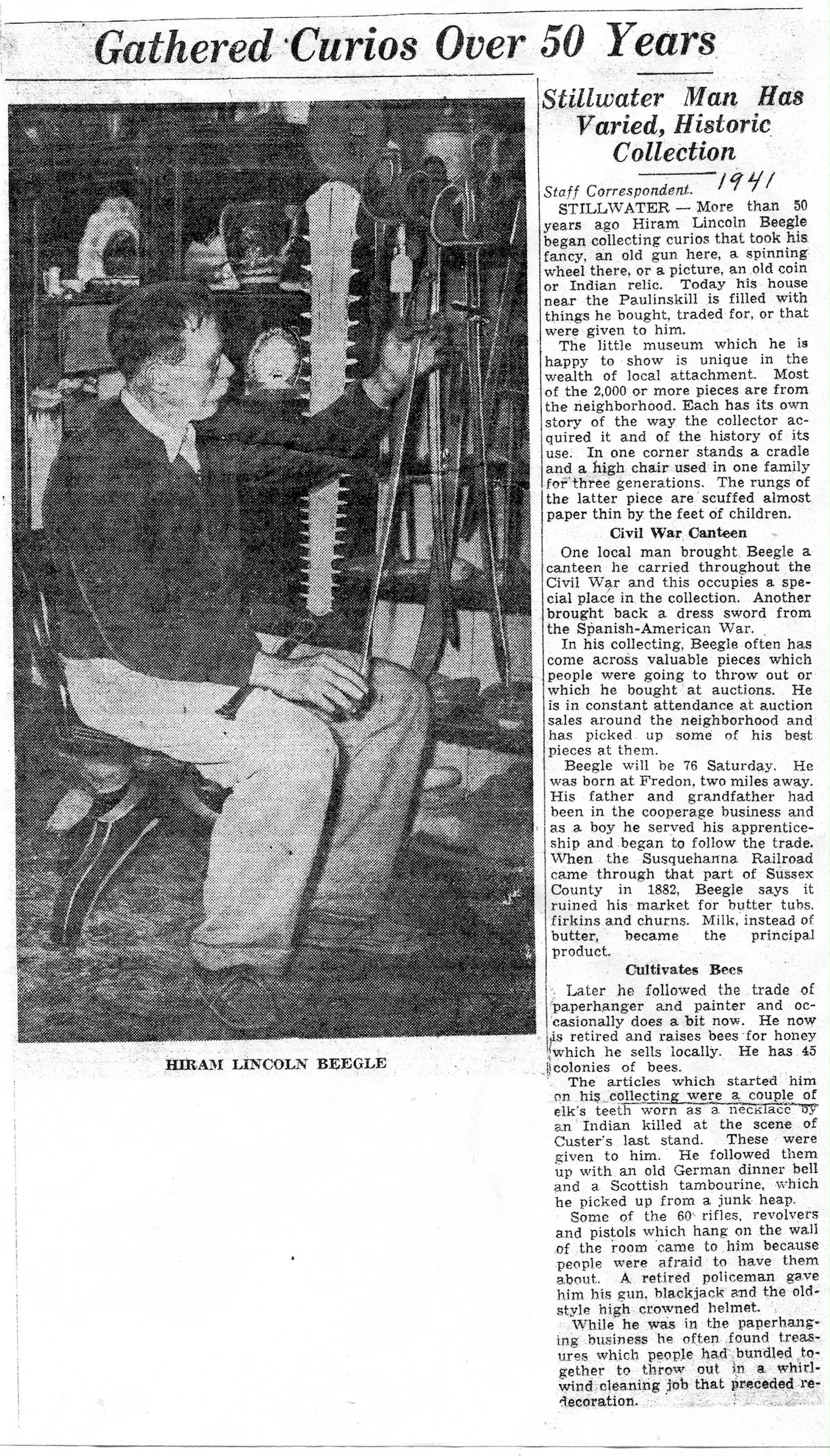Collection Background
The collection of the HSST Museum includes more than 10,000 objects. A large percentage of artifacts were donated by several individual collectors and many other gifts were made from members of the community over time.
Hiram Lincoln Beegle
The museum was born in 1954 when collector Hiram Beegle bequeathed hundreds of artifacts to the Mary Dixon Library in the Academy building. At the time he was employed by the library as the caretaker for the old building. A widower who lived alone in a house on the Paulinskill River in Stillwater, Beegle endeared himself to the librarians for whom he lit a fire every morning to warm the unheated old building. When he turned eighty, they surprised him with a birthday party. In his will, Beegle left the collection “to his girls” at the Library.
Beegle’s interests were eclectic, ranging from Native American artifacts to delicate ceramics of the Victorian era. His own favorite item was a wooden canteen from the revolutionary war which belonged to General Aron Hankinson. Both objects are on display in the military section upstairs. He had been collecting for more than 50 years while making a living as a cooper, or barrel maker, carpenter, lumberjack and, in his later years, a beekeeper.
Beegle’s involvement with the Academy building began long before he retired and became the caretaker. Born in Fredon, Hiram Lincoln Beegle attended elementary school in the Academy building. In 1910, when the student body moved to a new schoolhouse around the corner, Beegle joined the Patriotic Order Sons of America which occupied the premises for the next thirty years. Taking care of the building in his later years, Hiram Beegle was the lifelong guardian of the Academy. Only the giant Sycamore tree deeply rooted at the entrance has a longer history. Donating his beloved collection to his friends at the Academy was the most meaningful decision for him and one which has resulted in a significant expansion of knowledge about the history of Stillwater Township.
Doris Hupp
Doris Hupp donated most of the articles in the exhibition of women’s fashion. A nationally celebrated doll collector and conservator, Ms. Hupp owned one of the most extensive private collections of antique dolls in the United States. She was a sought-after lecturer on the history and restoration of antique dolls. Her career as an art teacher in New Jersey public schools led her to discover her passion for dolls when she assigned a student project inspired by Rachel Field’s 1929 children’s book, “Hitty: Her First Hundred Years.”
To ensure that her dolls wore only costumes that were historically accurate, she developed a collection of vintage clothing to serve as reference materials about fabrics, buttons and the many details which would distinguish each era of fashion. Many of these were cut into pieces to make doll clothing, but a handsome collection remained intact and is on display on the second floor of the Museum.
Frederick W. Hupp
Frederick W. Hupp, brother of Doris Hupp, was a craftsman who had taught machinery at the Essex County Vocational School in Newark, where Doris and he were born. He lived in Byram for many years and retired in Stillwater. He became a member of the Historical Society and donated a number of objects to the Museum including a detailed miniature farm and barnyard which he had crafted himself. Mr. Hupp also partnered with his sister Doris on occasion in outfitting mechanical dolls that sang, knitted and smoked. In 1992 Fred Hupp signed over to the Museum all of the objects that he and his late sister had loaned to the HSST over the years.
Dr. Edward Cosgrove
Dr. Edward Cosgrove was born in 1942 in Newton, NJ. and after he moved to Morristown as a young adult, he continued to spend many summers in Stillwater Township in the 50’s and 60’s helping relatives with farm chores and hotel work. His mother, Helen Vail, had been raised by her aunt Margaret Hill who owned Louis Lake House from 1910-1918 and later ran a boarding house. Margaret Hill lived on a farm in Middleville near Keen’s Mill with her daughter May Hill and son-in-law Levi Serey, who did the farming. In 2011 Dr. Cosgrove donated a large collection of Lenape artifacts which had been discovered on the Serey farm. The donation included a collection of old Stillwater postcards and photos, the earliest being a 1917 photo taken of the line crew who laid the first telephone lines in Swartswood.
Dr. Edward Cosgrove, lifetime member of HSST, donated a large collection of Native American artifacts, Stillwater photos and vintage postcards to the Society. His donation is a wonderful addition to HSST’s collection and we extend our thanks to Dr. Cosgrove for his generosity.
Following is just a sampling of items in the Cosgrove Collection. We encourage you to visit the Museum this summer during our Sunday openings to see the collection or -email- to arrange an appointment.
Native American Artifacts
The Native American artifacts were found on the property of Mr. Levi T. Serey. Mr Serey, a Middleville farmer in the early-mid 20th Century, was married to May Hill, Dr. Cosgrove’s relative. The farm was located on the current Route 521 in the Keen’s Mill area and is shown on the map below:

The artifacts range from arrowheads and axes to ornamental pieces and pestles.
Ax Head:
Gorget (ornamental piece worn around the neck; had a ceremonial purpose):
Nutter (used to grind nuts in the concave area):
Photo Albums
There are two photo albums in the Cosgrove Collection, both of which belonged to May Hill Serey. The earlier album (before circa 1917/1918) centers around the Lake House, a hotel May’s parents owned in Swartswood. The later album (post circa 1917/1918) centers around the Middleville farm that would later belong to May and Levi Serey. It had a boarding house called Lake Cottage as well as a schoolhouse.
This line crew, shown in Swartswood, laid the first phone lines in the area:

Levi Serey, working the Middleville farm:

Postcards
The postcards in the Cosgrove Collection primarily consist of Stillwater area postcards, though New Jersey at large and other geographic locations are represented. The messages on some of the postcards give us a glimpse into everyday life in our area in the early 20th Century. One postcard promises a secret if the reader looks under the stamp. Of course, the stamp is long gone – and the secret along with it.
Robbins Store:
Swartswood Post Office and General Store:
High Falls House:




